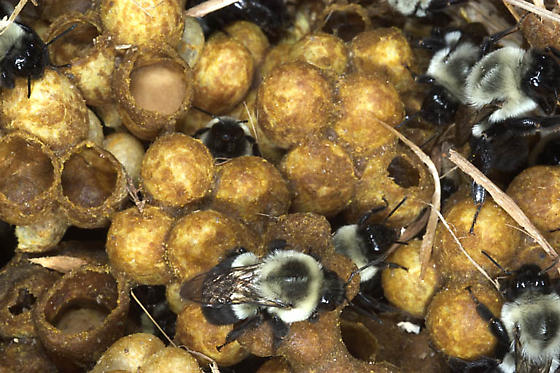.png)
Pollinator conservation does not stop when the weather turns cool.
There are a few items you can add to your pollinator to-do list for the fall and early winter to help pollinators next spring.
Leave lawn litter for nesting
Leaving fallen leaves in your landscape can have substantial benefits for next year’s pollinators. Although turfgrass experts tell us to remove fallen leaves from our turfgrass to prevent disease-causing conditions on our grasses, those leaves can have benefits when added around perennials as a mulch or at the edge of wood lines.
In many bumble bee (Bombus spp.) life cycles, mated queens go into diapause — similar to hibernation — when the weather turns cold. Their metabolism slows down and their biochemistry changes to allow them to survive winter conditions. These bees look for naturalized areas just under the ground or under leaf litter to wait out the winter. To facilitate this, make sure there are areas like this in your landscape.
Once spring arrives, the mated bumble bee queens come out of diapause and look for areas to create a nest, usually naturalized areas such as old rodent homes. Some bumble bees can create nests of up to 500 bees, and these pollinators emerge hungry and ready to pollinate your garden.
Many native bees use the hollow stems of spent flowers for nests. Leafcutter bees (Megachile spp.) and orchard bees (Osmia spp.) look for the hollow stems of black-eyed Susans (Rudbeckia hirta) or purple coneflowers (Echinacea purpurea) for spring nest making. Instead of throwing your hollow stems on the burn pile, leave them in place or move them to another area of your landscape, like the edge of any woods.
You could also break stems into segments of approximately 8 inches and gather them in a nesting box.
Cavity-nesting bee species look for hollow stems approximately the width of their bodies. Even small hollow stems are useful to small native bees. The bees will thank you by pollinating your 2022 garden.
Plan for next year

Did you make notes on what pollinator plants in your garden performed well in 2021? Did you see something spectacular when visiting a public garden that you wanted to add to your landscape? Take some time to evaluate your garden, as fall is an appropriate time to plant perennials and trees.
Trees are an underappreciated part of the pollinator garden. For example, maple trees will produce thousands of nectar-rich blooms early in the spring season and early emerging pollinators flock to their inconspicuous flowers. Since the upper soil (6 to 8 inches deep) does not freeze in Georgia winters, planting now will allow the plants to produce some roots during the cool season. The University of Georgia Cooperative Extension publication "Selecting Trees and Shrubs as Resources for Pollinators" may be helpful.
When the weather really turns cold, consider learning more about our native pollinators. There are several books that will help you increase your identification skills so you will recognize more of your insect visitors next year. "The Bees in Your Backyard" and "Common Bees of Eastern North America" by Joseph Wilson and Olivia Carril, and "Butterflies of Georgia" by Jaret Daniels are useful guides for beginners and experienced insect appreciators. Learning one or two new species a year is a worthy goal.
Finally, as the growing season winds down take a moment to recognize all you have done for pollinators this year. Whether you added a new pollinator garden, decreased your insecticide use, participated in the Great Georgia Pollinator Census, or introduced your children or grandchildren to insects, it all makes a difference.






